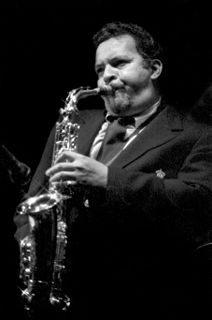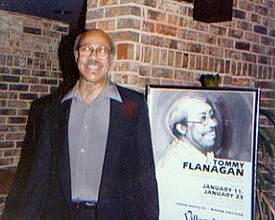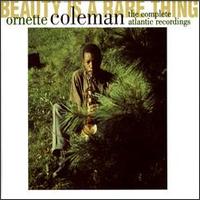A major contributor to this article appears to have a close connection with its subject.(July 2019) |
Zan Stewart (born March 29, 1944) is an American jazz writer, musician and former disc jockey.
A major contributor to this article appears to have a close connection with its subject.(July 2019) |
Zan Stewart (born March 29, 1944) is an American jazz writer, musician and former disc jockey.
Born in Los Angeles, California, Stewart is the son of Cassius Lynford Stewart (1907–1997) and Elizabeth LeGrange Wilbur Stewart (1904–1992). In the 1930s and 1940s, his father was as an accountant for such Los Angeles area film studios as Universal, Eagle Lion and RKO, working on films that included two directed by Howard Hawks: The Thing (From Another World) and The Big Sky. Later, he was an auditor for Ventura County, California, treasurer of Ojai Festivals, Ltd., and producer of jazz concerts for the Festivals, and, with Gene Lees and Fred Hall, of several seasons of Jazz At Ojai, for which he designed the event's logo. A musician, he played piano—he studied with the fine pianist Theo Saunders—and guitar, and was also a cartoonist, whose works appeared in the Ojai, California-based Ojai Valley Voice. Stewart's mother, whose professional name was Elizabeth Wilbur, was an actress from the late 1920s until the 1940s, appearing on stage, in two films -- "Bonnie Scotland" (1934) and "Robin Hood of El Dorado" (1936) -- and on radio, including roles on Cecil B. DeMille's "Lux Radio Theater." Stewart's maternal grandmother was the playwright Helen Hannah Wilbur (1878–1937), who wrote numerous plays under the name Elene Wilbur and also contributed scripts for the Christian Science radio program, "Courage Corner."
Stewart became fascinated with jazz as a teenager growing up in Ojai, California, where he moved with his parents in 1955, and was introduced to jazz journalism through extensive reading of Down Beat magazine, to which he would later contribute, beginning in the 1980s. He first contributed jazz writing to Paul Afeldt's Ventura, California-based Jazz Review while still in high school, then began his professional career in 1975 with a bi-weekly column for the Santa Barbara (Ca.) News and Review. (He graduated from the University of California Santa Barbara with a BA in Film Studies in 1974.) After moving to Los Angeles in 1977, he started writing for the L.A. Weekly in 1979, which brought him to the attention of Los Angeles Times jazz critic Leonard Feather, who brought him on the paper in 1980, where he was later mentored by arts editor Fred Crafts. Stewart wrote features for the L.A. Times, including a weekly "Jazz Notes" column, as well as reviews of performances and recordings, jazz listings, and more. His colleagues included jazz writer Don Heckman and noted food writers Colman Andrews, a friend since adolescence in Ojai, and Ruth Reichl.
Stewart has also written for Down Beat , Jazz Life, Swing Journal, Jazziz, Musica Jazz, and, from 2002 to 2010, the Newark Star-Ledger , New Jersey's largest newspaper, from which he retired in 2010. During his writing career, he interviewed such major jazz artists as Miles Davis, Dizzy Gillespie, Horace Silver, Joe Henderson, Barry Harris, Wayne Shorter and Ornette Coleman. Stewart has written liner notes to more than 200 albums and box sets. In 1994, he received a Certificate of Commendation from the City of Los Angeles, and a Jazz Communicator Award from the Los Angeles Jazz Society. In 1996, he was a recipient of the ASCAP-Deems Taylor Award in recognition of his liner notes to Eric Dolphy: The Complete Prestige Recordings. [1] His interviews are in two books: "The Quincy Jones Interview," included in "Down Beat Magazine's The Great Jazz Interviews, a 75th Anniversary Anthology,"; [2] and "Ornette Coleman: Interviewed by Zan Stewart and Howard Shore," Shuffle Boil, No. 7. [3]
Stewart's interest in instrumental music began with piano studies at age 5, followed by clarinet at the age of six, and saxophone at the age of 15. His musical career began in earnest as a tenor saxophonist in Santa Barbara in 1975, where he played in two bands, Crescent and Steamroller, the latter with noted drummer Gary Frommer. In Los Angeles, he led ensembles and performed at such venues as LeCafe, Pedrini Music, At My Place, and Jax. He was also heard regularly with saxophonists Pat Britt—who produced recordings by such notables as saxophonists Sonny Stitt and George Coleman—and Wilbur Brown—who had played with singer/pianist Ray Charles, saxophonist Hank Crawford, trumpeter Kenny Dorham and pianist Red Garland, among many others—at the Cat and Fiddle Pub in Hollywood. The Cat & Fiddle was owned by bassist Kim Gardner, a noted English rock musician who played with the likes of Eric Clapton, George Harrison and Rod Stewart, and co-led Ashton, Gardner & Dyke. While living in the Eastern U.S., Stewart played at Smalls in New York City, and Shanghai Jazz, Trumpets Jazz Club and Cecil's Jazz Club in New Jersey. Currently residing in the San Francisco Bay Area, he has played Club Deluxe in San Francisco, the 7 Mile House in Brisbane, at Nick's Lounge and Mythos Fine Art in Berkeley, Osteria Divino in Sausalito, and Terrapin Crossroads in San Rafael. In 2014 he released his debut CD, The Street Is Making Music (MoboDog Records), which has received substantial U.S. and international airplay and several positive reviews. In 2015, Zan played solo tenor saxophone alongside poets David Meltzer, who first read his poetry to jazz in the late 1950s in San Francisco, and Julie Rogers in recording "Two-Tone - Poetry & Jazz" (Pureland Audio).
He names Sonny Rollins and Charlie Parker as a principal influences, and also cites Dexter Gordon, Miles Davis, Thelonious Monk, Lee Morgan, Herbie Hancock, John Coltrane, and Fats Navarro as models. [1] [4]
Among the musicians Stewart has performed with are pianists Albert Dailey, Gildo Mahones, Freddie Redd, Keith Saunders, Art Hillery, and Tardo Hammer; guitarists Bob DeVos and Dave Stryker; bassists Paul Gill, Louis Spears, Bill Moring, John Wiitala, Adam Gay, and Mike Karn; drummers Clarence Johnston, Roy McCurdy, Jimmy Cobb, Ron Marabuto, Tony Reedus, Steve Johns, and Tim Horner; and saxophonists Wilbur Brown, Pat Britt, Frank Morgan, Joe Lovano, Dewey Redman, and Grant Stewart.
Stewart was a disc jockey from 1964 to 1982, first on the UCSB station, KCSB-FM. He joined both KOVA-FM (Ojai, Ca,) and KTMS-FM (Santa Barbara) in the mid-1970s, and was later heard on two Los Angeles area radio stations: [5] KBCA-FM (later KKGO), 1977 to 1980; and KCRW, 1980 to 1982.
Stewart is a member of the American Society of Composers, Authors and Publishers (ASCAP).

Randolph Denard Ornette Coleman was an American jazz saxophonist, violinist, trumpeter, and composer known as a principal founder of the free jazz genre, a term derived from his 1960 album Free Jazz: A Collective Improvisation. His pioneering performances often abandoned the chordal and harmony-based structure found in bebop, instead emphasizing a jarring and avant-garde approach to improvisation.

John Lenwood "Jackie" McLean was an American jazz alto saxophonist, composer, bandleader, and educator, and is one of the few musicians to be elected to the DownBeat Hall of Fame in the year of their death.

Donald Eugene Cherry was an American jazz trumpeter. Cherry had a long association with free jazz saxophonist Ornette Coleman, which began in the late 1950s. He also performed alongside musicians such as John Coltrane, Charlie Haden, Sun Ra, Ed Blackwell, the New York Contemporary Five, and Albert Ayler.

Walter Theodore "Sonny" Rollins is an American jazz tenor saxophonist who is widely recognized as one of the most important and influential jazz musicians. In a seven-decade career, he has recorded over sixty albums as a leader. A number of his compositions, including "St. Thomas", "Oleo", "Doxy", "Pent-Up House", and "Airegin", have become jazz standards. Rollins has been called "the greatest living improviser" and the "Saxophone Colossus".

Frederick Dewayne Hubbard was an American jazz trumpeter. He played bebop, hard bop, and post-bop styles from the early 1960s onwards. His unmistakable and influential tone contributed to new perspectives for modern jazz and bebop.

Sheldon Manne, professionally known as Shelly Manne, was an American jazz drummer. Most frequently associated with West Coast jazz, he was known for his versatility and also played in a number of other styles, including Dixieland, swing, bebop, avant-garde jazz and fusion, as well as contributing to the musical background of hundreds of Hollywood films and television programs.

Charles Edward Haden was an American jazz double bass player, bandleader, composer and educator whose career spanned more than 50 years. In the late 1950s, he was an original member of the ground-breaking Ornette Coleman Quartet.

James "Blood" Ulmer is an American jazz, free funk and blues guitarist and singer. Ulmer plays a Gibson Byrdland guitar. His guitar sound has been described as "jagged" and "stinging". His singing has been called "raggedly soulful".

Benjamin Francis Webster was an American jazz tenor saxophonist.

Paul Bley, CM was a jazz pianist known for his contributions to the free jazz movement of the 1960s as well as his innovations and influence on trio playing and his early live performance on the Moog and Arp audio synthesizers. His music has been described by Ben Ratliff of the New York Times as "deeply original and aesthetically aggressive". Bley's prolific output includes influential recordings from the 1950s through to his solo piano recordings of the 2000s.

The Shape of Jazz to Come is the third album by jazz musician Ornette Coleman. Released on Atlantic Records in 1959, it was his debut on the label and his first album featuring the working quartet including himself, trumpeter Don Cherry, bassist Charlie Haden, and drummer Billy Higgins. The recording session for the album took place on May 22, 1959, at Radio Recorders in Hollywood, California. Although Coleman initially wished for the album to be titled Focus on Sanity after the LP's fourth track, Atlantic producer Nesuhi Ertegun suggested the final title, feeling that it would give consumers "an idea about the uniqueness of the LP."

Charles Lloyd is an American jazz musician. Though he primarily plays tenor saxophone and flute, he has occasionally recorded on other reed instruments, including alto saxophone and the Hungarian tárogató. Lloyd's primary band since 2007 has been a quartet including pianist Jason Moran, acoustic bassist Reuben Rogers, and drummer Eric Harland.
Mike Miller is a rock and jazz guitarist. He has worked with Chick Corea, Bette Midler, Yellowjackets, Brand X, Burton Cummings, Vinnie Colaiuta, Quincy Jones, Gino Vannelli, Vital Information.

Old and New Dreams was an American jazz group. that was active from 1976 to 1987. The group was composed of tenor saxophone player Dewey Redman, bassist Charlie Haden, trumpeter Don Cherry and drummer Ed Blackwell. All of the members were former sidemen of free jazz progenitor and alto saxophonist Ornette Coleman, and the group played a mix of Coleman's compositions and originals by the band members.

Thomas Lee Flanagan was an American jazz pianist and composer. He grew up in Detroit, initially influenced by such pianists as Art Tatum, Teddy Wilson, and Nat King Cole, and then by bebop musicians. Within months of moving to New York in 1956, he had recorded with Miles Davis and on Sonny Rollins' album Saxophone Colossus. Recordings under various leaders, including Giant Steps of John Coltrane, continued well into 1962, when he became vocalist Ella Fitzgerald's full-time accompanist. He worked with Fitzgerald for three years until 1965, and then in 1968 returned to be her pianist and musical director, this time for a decade.

The Avant-Garde is an album credited to jazz musicians John Coltrane and Don Cherry that was released in 1966 by Atlantic Records. It features Coltrane playing several compositions by Ornette Coleman accompanied by the members of Coleman's quartet: Cherry, Charlie Haden, and Ed Blackwell. The album was assembled from two unissued recording sessions at Atlantic Studios in New York City in 1960.

Something Else!!!! is the 1958 debut album by jazz saxophonist Ornette Coleman. According to AllMusic, the album "shook up the jazz world", revitalizing the union of blues and jazz and restoring "blues to their 'classic' beginnings in African music". It is unusual in Coleman's output in that it features a conventional bebop quintet instrumentation ; after this album, Coleman would omit the piano, creating a starker and more fluid sound.

Norman Gary Foster is an American musician who plays saxophone, clarinet, and flute. He is considered a crossover artist, performing jazz, pop, and classical music. He has been prominent in the film, television, and music industries for five decades, having performed on over 500 movie scores and with over 200 orchestras.

Beauty Is a Rare Thing is a compilation box set collecting all the master recordings made for Atlantic Records between 1959 and 1961 by the American jazz composer and saxophonist Ornette Coleman. The set was released on Rhino Records in 1993, and reissued in March 2015.
Thomas John Ranier is an American instrumentalist who primarily plays piano but also saxophone and clarinet. As a jazz artist he has recorded widely under his own name and as a sideman for Warner Bros., Concord Records and several other labels. He has been prominent in the film, television, and music recording industry since the 1970s. He has played keyboards, woodwinds and writing music for a long list of assignments, including Grammy, Academy Award, Emmy, and Golden Globe winning media and soundtracks for artists such as Barbra Streisand, Shirley Bassey, Michael Feinstein, Christina Aguilera, Joe Pass, Plácido Domingo, Barry Manilow, Natalie Cole, and many others. As a pianist and jazz artist, "(his) personal approach mixes aspects of Bud Powell's complexity, Oscar Peterson's ardent swing and Bill Evans' exploratory harmonies."